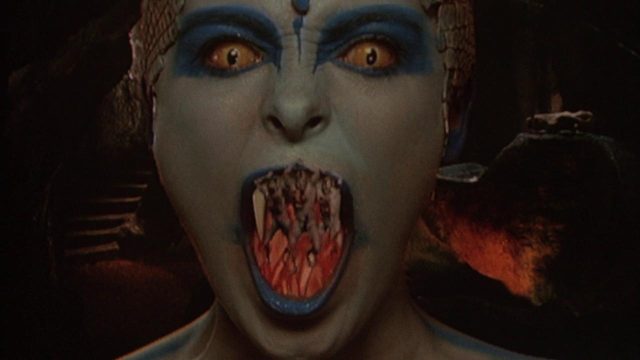Bram Stoker’s final novel, published the year before he died (allegedly) of syphilis, was loosely inspired by the British legend of the Lambton Worm — a giant snake/fish/dragon (it varies in the telling) that caused havoc in Northeastern England until it was slain by a man who kitted himself out with spiked armor so that it would be unable to crush him without killing itself. Stoker moved the action to another part of the country — the picturesque Peak District, from where I write to you today — and, judging by the plot synopsis, threw pretty much everything away, added vampires, and made it immeasurably more racist. Wikipedia claims that it is “widely considered one of the worst books ever written,” and several citations are given, including an essay by H.P. Lovecraft who said that it “utterly ruins a magnificent idea by a development almost infantile.” Perhaps it wasn’t racist enough?
However, the poor quality of the novel failed to deter Ken Russell, an admirer of Stoker who had written an adaptation of Dracula that he never managed to get made. Realizing that it might be easier to make a movie in Derbyshire than Transylvania, and with a “make a horror movie for us, and we’ll finance something else for you” deal from Vestron Pictures on the table, Russell dismantled the novel (which “falls short of itself in terms of credibility,” in his words) and fashioned the basic outline into a deliciously strange horror-comedy packed with bizarre dream sequences, near-catastrophic accents, before-they-were-famous faces and autumnal British countryside.
The Lair of the White Worm opens on Angus, a Scottish archaeological student digging up the gardens of a farmhouse. He’s hoping to find Roman artifacts, but discovers a mysterious creature’s well-preserved skull instead. His eureka moment may well be followed by one from the viewer — if they’re as slow as me — as they realize that underneath the glasses and shaggy hair is a disturbingly young Peter Capaldi. He’s staying at the farm with a pair of sisters who have been running the guest house since the mysterious disappearance of their parents a year earlier — a traumatic event that has left them each suffering from a deeply unconvincing Derbyshire accent.
Angus is dragged to the party a wealthy neighbor (an equally disturbingly-young Hugh Grant, somehow playing even posher than usual) is throwing in honor of his ancestor who vanquished the D’Ampton Worm (any resemblance to other mythical worms is entirely intentional). Angus quickly realizes that his discovery may be linked to the legend, but not quickly enough to prevent another neighbor sneaking into the house and making off with the skull, pausing only to spit venom through her fangs at a statue of Jesus as she leaves. There only seem to be three houses in this village (and one policeman), but I think it’s fair to say Everyone Has A Thing Going On. Lady Sylvia Marsh (Amanda Donohoe)’s thing is that she’s an immortal snake vampire femme fatale who seduces and bites everyone she meets in order to serve the gigantic worm that lives beneath the town.
It may seem like I’m throwing out a bunch of spoilers there, but this movie has absolutely no subtlety and doesn’t really keep any of this stuff a mystery from the viewer (the characters take a little longer to catch on). Suspense, ambiguity and tension are not the reasons to stick with this movie — overacting, insane visuals and the fact that it’s absolutely bananas? Yeah, that’s more like it. The first bizarre dream sequence kicks in when one of the local girls touches the poisoned Jesus statue, and is immediately transported into a deranged hallucination of Jesus being crushed on the cross by a giant snake, while a battalion of Roman soldiers ravage their way through a convent. Later on, a sleeping Hugh Grant enters the painting in his bedroom and boards a plane where he attempts to complete a crossword in the newspaper before being strapped down and drugged by Donohoe. It’s all rather wonderful, and the mixture of surreal humor, dream logic and sinister undertones feels blissfully Twin Peaks-esque without actually resembling it in the slightest (which is no surprise — this came first).
It’s hard to make a case that The Lair of the White Worm is wholly successful. It was clearly designed as a comedy and it successfully manages not to take itself seriously at all, but it’s only when it blends the stranger elements into the humor that everything really clicks. Amanda Donohoe in particular is operating on an entirely different level to the rest of the cast, and the more she’s involved, the better the movie gets — early scenes of clunky “only policeman in the village” jokes and shaky accents are quickly forgotten when Donohoe is delivering sinister monologues, nude, from a sunbed or seducing a teenage boy over a game of Snakes & Ladders (You see? I wasn’t kidding about the lack of subtlety).
I can see how the film as a whole might fall flat for some viewers, but for me the high points are so wonderfully insane that the flaws are easily forgotten. I’m sure it’s not the work that Ken Russell (or Grant or Capaldi for that matter) would want to be remembered for, but it is different from any other horror movie I’ve ever seen, and it deserves a place in the canon for Donohoe’s incredible performance alone.

